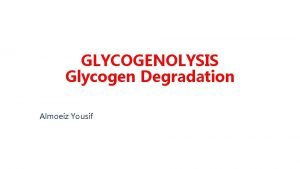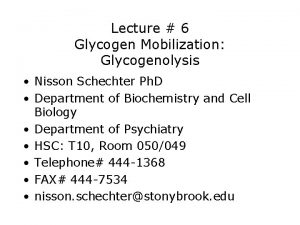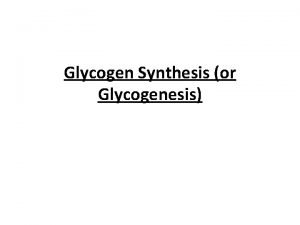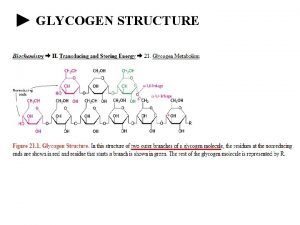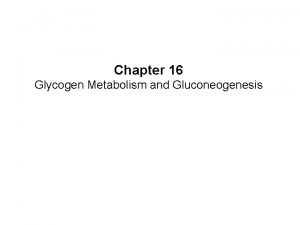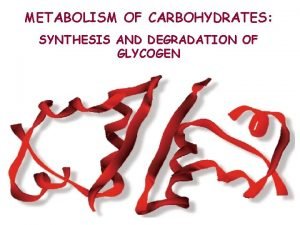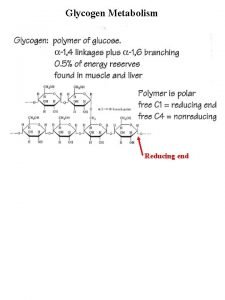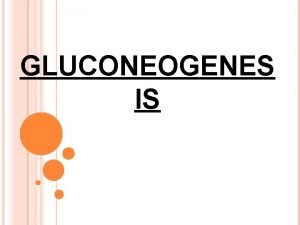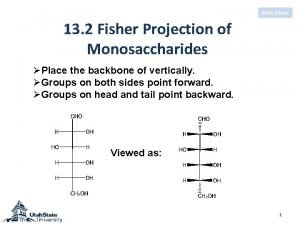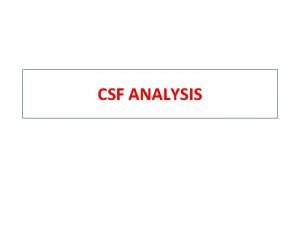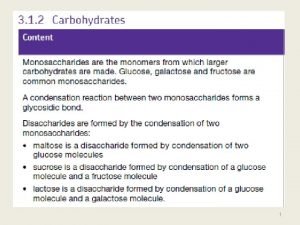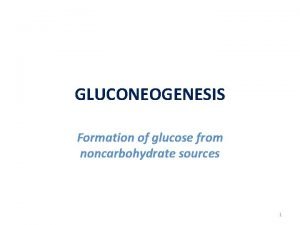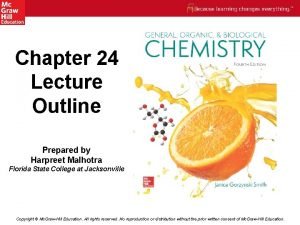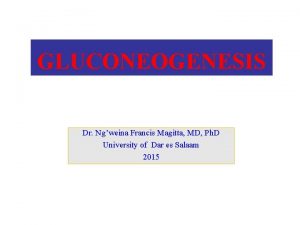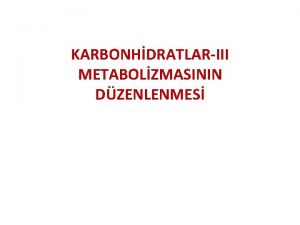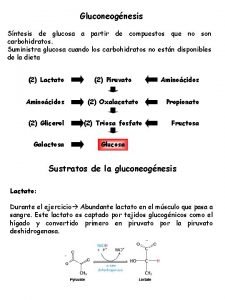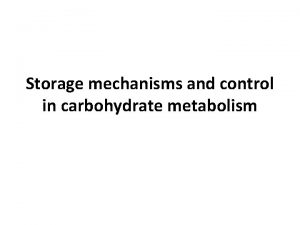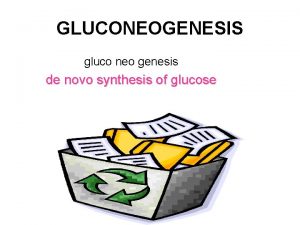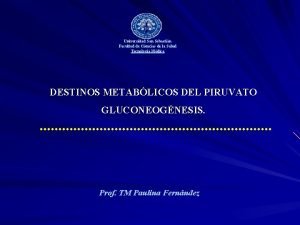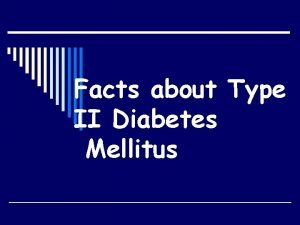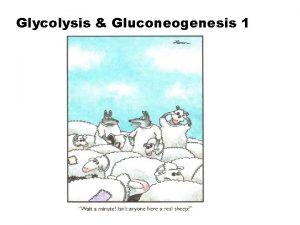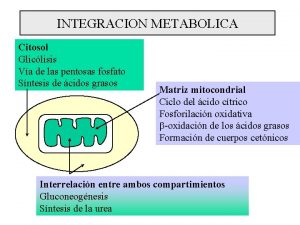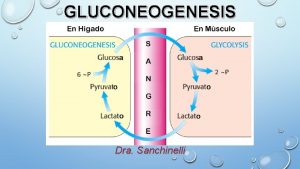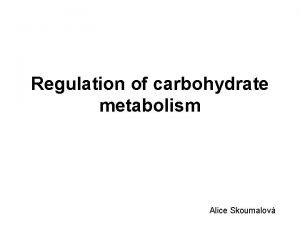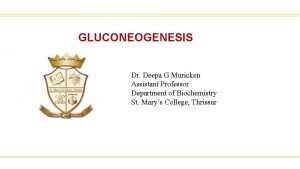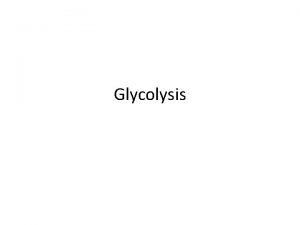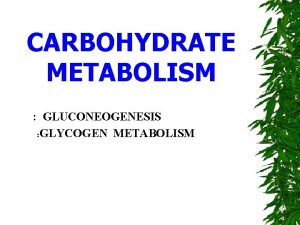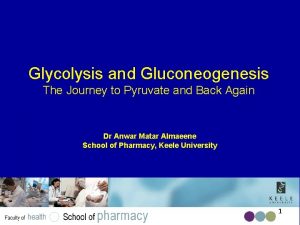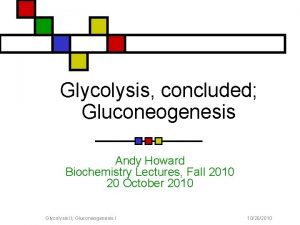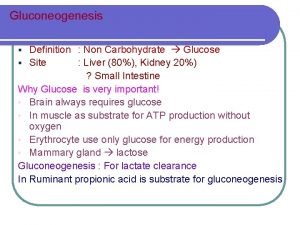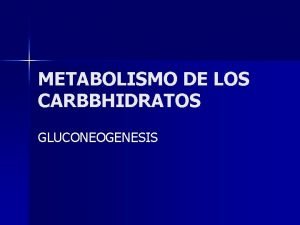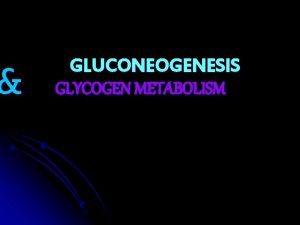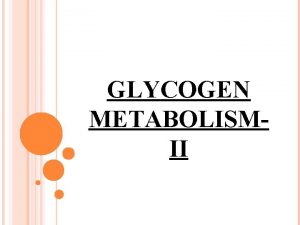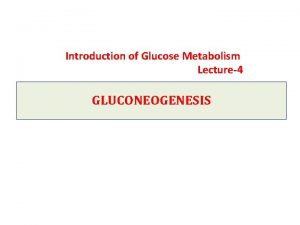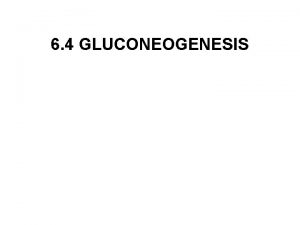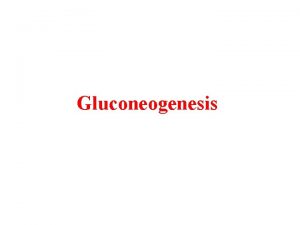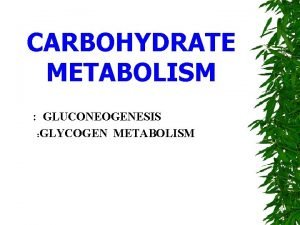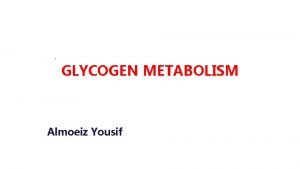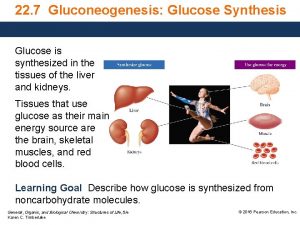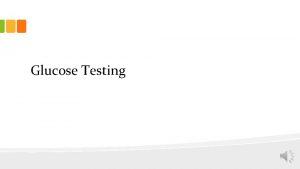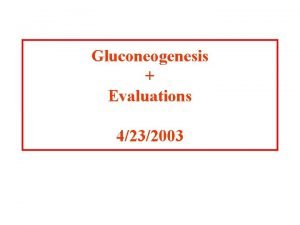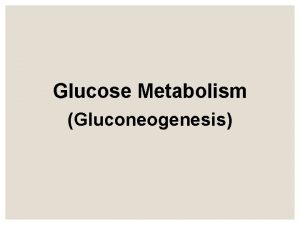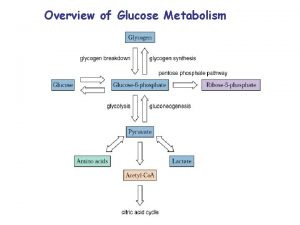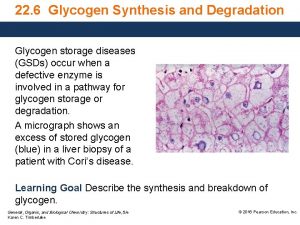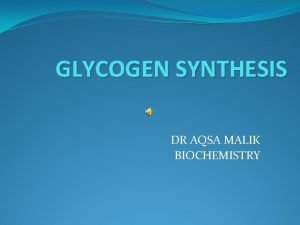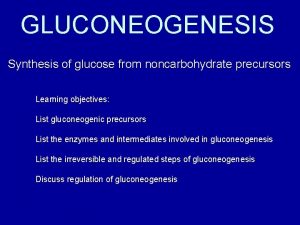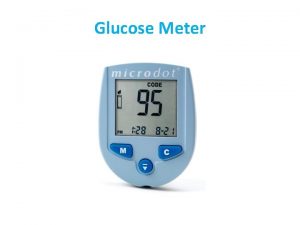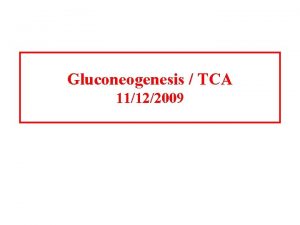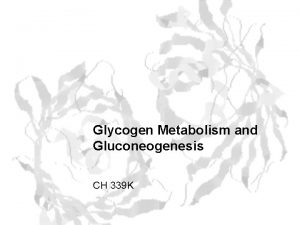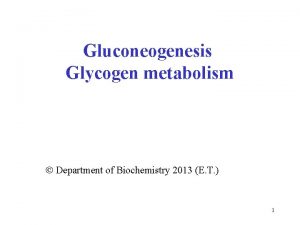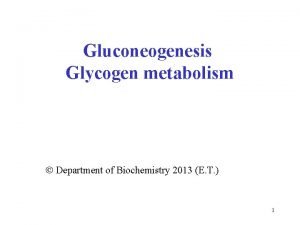GLUCONEOGENES IS GLUCONEOGENESIS Synthesis of glucose or glycogen































- Slides: 31

GLUCONEOGENES IS

GLUCONEOGENESIS Synthesis of glucose or glycogen from non carbohydrate sources. o During Fasting, in the first 12 hours, gluconeogenesis increases. o After 24 hours, it is the sole source of glucose.

THE BLOOD CONCENTRATION OF GLUCOSE MUST BE REGULATED WITHIN NARROW LIMITS Blood Glucose is derived from: � Diet � Glycogenolysis � Gluconeogenesis During Starvation, when dietary Glucose is not available and Hepatic Glycogen stores are depleted , the major source of Glucose for blood is Gluconeogenesis. The process takes place in the liver, kidneys and the small intestine

The Major source of Glucose for the body is the dietary carbohydrates (Exogenous Source) Endogenous source (Gluconeogenesis): � Gluconeogenesis is the process of synthesizing glucose or glycogen from non-carbohydrate precursors. � The major substrates are the glucogenic amino acids, lactate, glycerol, and propionate.

BIOMEDICAL IMPORTANCE Gluconeogenesis meets the needs of the body for glucose when insufficient carbohydrate is available from the diet or glycogen reserves. A supply of glucose is necessary especially for the nervous system and erythrocytes. Failure of gluconeogenesis is usually fatal. Hypoglycemia causes brain dysfunction, which can lead to coma and death. Gluconeogenesis clears lactate produced by muscle and erythrocytes and glycerol produced by adipose tissue.

THUS, THE FUNCTIONS OF GLUCONEOGENESIS ARE à Maintenance à To of Blood glucose levels clear the intermediate products of metabolism from the cell

GLUCONEOGENESIS IS THE PATHWAY OF CONVERTING NON-CARBOHYDRATE PRECURSORS TO GLUCOSE Two groups of compounds that undergo Gluconeogenesis: � (1) Those which are the products of the metabolism of glucose in tissues. � (2) Those which are obtained by Catabolism of Non-Carbohydrate Compounds, e. g. Amino acids, Glycerol, Propionate.

SUBSTRATES OF GLUCONEOGENESIS: GLUCOGENIC AMINO ACIDS Glucogenic Amino Acids (example glycine, serine, alanine and aspartate) act as substrates for gluconeogenesis. If the carbon skeleton of the amino acids gives pyruvate or alanine, the amino acids are said to be glucogenic. If the carbon skeleton of the amino acids gives acetoacetate or acetyl Co. A, the amino acids are said to be ketogenic. (Pure ketogenic are lysine and leucine)

SUBSTRATES OF GLUCONEOGENESIS: GLUCOGENIC AMINO ACIDS


SUBSTRATES OF GLUCONEOGENESIS: PROPIONYL CO A AND GLYCEROL Propionate is a three carbon compound which is obtained by the beta oxidation of odd chain fatty acids. TAGs are mobilized from lipid reserves and they are broken down into free fatty acids and glycerol. Odd chain fatty acids yield propionyl Co A.

SUBSTRATES OF GLUCONEOGENESIS: PROPIONATE

PROPIONYL CO A TO SUCCINLY CO A

GLYCEROL AS A SUBSTRATE

SUBSTRATES OF GLUCONEOGENESIS: LACTATE Lactate which is produced in the muscles as well as the red blood cells is also a substrate for gluconeogenesis.

FORMATION OF LACTIC ACID IS A NORMAL PHENOMENON IN SPECIAL CIRCUMSTANCES Exercising Skeletal muscle cells. Red Blood Cells. Anaerobic Organisms.

CONVERSION OF PYRUVATE TO LACTATE



PYRUVATE IS PRODUCED AS AN INTERMEDIATE OF GLUCOSE, AMINO ACID AND LIPID METABOLISM Glucose Amino Acids Glycerol Pyruvate

METABOLISM OF PYRUVIC ACID Metabolic Sources of Pyruvic Acid: � Glycolysis. � Glycerol Metabolism. � Amino Acid Catabolism. Pathways of Pyruvate Metabolism: � Formation of Acetyl~Co. A (oxidative decarboxylation) � Formation of Lactic acid (Anaerobic glycolysis). � Formation of Alanine (Transamination). � Conversion to Oxaloacetic acid (carboxylation).

GLYCOLYSIS: A SERIES OF ENZYME CATALYZED REACTIONS TO GENERATE ENERGY (ATP) Gradual breakdown of glucose to: Pyruvic acid (aerobic) or Lactic acid (anaerobic) Glucose Fruc. 1, 6 bi-P Gly. 3 -P 1, 3 -DPG Pyruvic Acid Lactic Acid

Glucose G-6 -P F-6 -P Glyceraldehyde 3 -P 1, 3 diphosphoglycerate Fructose-1, 6 bi-P Dihydroxyacetone-P 3 -Phosphoglycerate Phospo enol pyruvate Pyruvate Lactate

FORMATION OF GLUCOSE FROM PYRUVATE REVERSAL OF GLYCOLYSIS Glucose G-6 -P F-6 -P Glycerald. 3 -P 1, 3 diphosphoglycerate Fructose-1, 6 bi-P Dihydroxyacetone-P 3 -Phosphoglycerate Phospo enol pyruvate Pyruvate Lactate

REVERSAL OF GLYCOLYSIS IS NOT POSSIBLE WITHOUT SPECIFIC ENZYMES AND MECHANISM Glucose G-6 -P Fructose-1, 6 bi-P F-6 -P Phosphatases Phospo enol pyruvate Oxaloacetate Pyruvate Carboxylation

ENZYMES INVOLVED IN GLUCONEOGENESIS Gluconeogenesis is not a direct reverse of glycolysis because there are three irreversible steps in glycolysis. The bypassing of these steps requires four enzymes which include 1. Pyruvate carboxylase (requires biotin) 2. Phosphoenol pyruvate carboxy kinase 3. Fructose 1, 6 - Bisphosphatase 4. Glucose 6 Phosphatase

GLUCONEOGENESIS


CLINICAL Alcoholism is associated with hypoglycemia. This is because Alcohol is metabolized to acetate and there is production of high levels of NADH which alter the gluconeogenic pathway.

HORMONES INVOLVED IN GLUCONEOGENESIS Glucagon Insulin Cortisol

REGULATION
 Glycogen phosphorylase
Glycogen phosphorylase R and t state
R and t state Glycogenolysis youtube
Glycogenolysis youtube Glycogen pathway
Glycogen pathway Glycogen breakdown
Glycogen breakdown Cycle alanine glucose
Cycle alanine glucose Reducing end of glycogen
Reducing end of glycogen Regulation of gluconeogenesis
Regulation of gluconeogenesis Glucose seliwanoff test
Glucose seliwanoff test D glucose and l glucose
D glucose and l glucose Csf glucose vs blood glucose
Csf glucose vs blood glucose Alpha glucose vs beta glucose
Alpha glucose vs beta glucose The production of glucose from noncarbohydrate sources
The production of glucose from noncarbohydrate sources Glucose synthesis from non-carbohydrate sources
Glucose synthesis from non-carbohydrate sources Gluconeogenesis from lactate
Gluconeogenesis from lactate Gluconeogenesis nedir
Gluconeogenesis nedir Regulacion de gluconeogenesis
Regulacion de gluconeogenesis Examples of physical function of art
Examples of physical function of art Cori cycle
Cori cycle Precursores de gluconeogenesis
Precursores de gluconeogenesis Glycogenolysis and gluconeogenesis
Glycogenolysis and gluconeogenesis Glucokinase
Glucokinase Degradacion de la glucosa
Degradacion de la glucosa Precursores de gluconeogenesis
Precursores de gluconeogenesis Glycolysis
Glycolysis Pyruvate carboxylase gluconeogenesis
Pyruvate carboxylase gluconeogenesis Pyruvate dehydrogenase
Pyruvate dehydrogenase Net reaction of gluconeogenesis
Net reaction of gluconeogenesis Reversible reactions in glycolysis
Reversible reactions in glycolysis Glucose 6 phosphatase
Glucose 6 phosphatase Gluconeogenesis definition
Gluconeogenesis definition Gluconeogenesis sustrato y producto
Gluconeogenesis sustrato y producto
